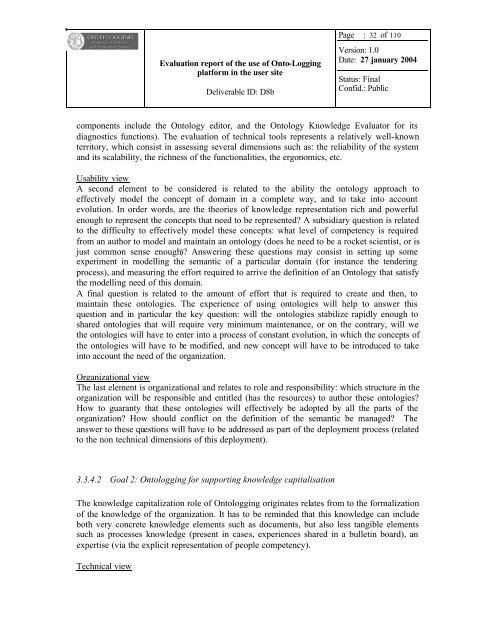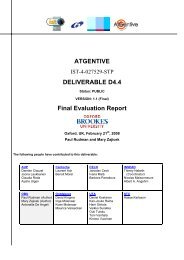pdf 820Kb - INSEAD CALT
pdf 820Kb - INSEAD CALT
pdf 820Kb - INSEAD CALT
You also want an ePaper? Increase the reach of your titles
YUMPU automatically turns print PDFs into web optimized ePapers that Google loves.
Evaluation report of the use of Onto-Logging<br />
platform in the user site<br />
Deliverable ID: D8b<br />
Page : 32 of 110<br />
Version: 1.0<br />
Date: 27 january 2004<br />
Status: Final<br />
Confid.: Public<br />
components include the Ontology editor, and the Ontology Knowledge Evaluator for its<br />
diagnostics functions). The evaluation of technical tools represents a relatively well-known<br />
territory, which consist in assessing several dimensions such as: the reliability of the system<br />
and its scalability, the richness of the functionalities, the ergonomics, etc.<br />
Usability view<br />
A second element to be considered is related to the ability the ontology approach to<br />
effectively model the concept of domain in a complete way, and to take into account<br />
evolution. In order words, are the theories of knowledge representation rich and powerful<br />
enough to represent the concepts that need to be represented? A subsidiary question is related<br />
to the difficulty to effectively model these concepts: what level of competency is required<br />
from an author to model and maintain an ontology (does he need to be a rocket scientist, or is<br />
just common sense enough)? Answering these questions may consist in setting up some<br />
experiment in modelling the semantic of a particular domain (for instance the tendering<br />
process), and measuring the effort required to arrive the definition of an Ontology that satisfy<br />
the modelling need of this domain.<br />
A final question is related to the amount of effort that is required to create and then, to<br />
maintain these ontologies. The experience of using ontologies will help to answer this<br />
question and in particular the key question: will the ontologies stabilize rapidly enough to<br />
shared ontologies that will require very minimum maintenance, or on the contrary, will we<br />
the ontologies will have to enter into a process of constant evolution, in which the concepts of<br />
the ontologies will have to be modified, and new concept will have to be introduced to take<br />
into account the need of the organization.<br />
Organizational view<br />
The last element is organizational and relates to role and responsibility: which structure in the<br />
organization will be responsible and entitled (has the resources) to author these ontologies?<br />
How to guaranty that these ontologies will effectively be adopted by all the parts of the<br />
organization? How should conflict on the definition of the semantic be managed? The<br />
answer to these questions will have to be addressed as part of the deployment process (related<br />
to the non technical dimensions of this deployment).<br />
3.3.4.2 Goal 2: Ontologging for supporting knowledge capitalisation<br />
The knowledge capitalization role of Ontologging originates relates from to the formalization<br />
of the knowledge of the organization. It has to be reminded that this knowledge can include<br />
both very concrete knowledge elements such as documents, but also less tangible elements<br />
such as processes knowledge (present in cases, experiences shared in a bulletin board), an<br />
expertise (via the explicit representation of people competency).<br />
Technical view
















